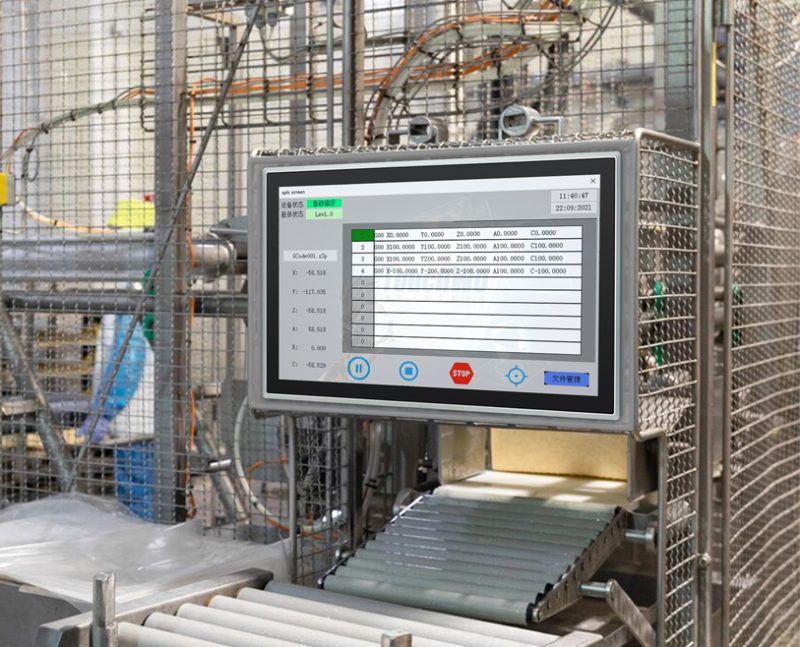في الأتمتة الصناعية الحديثة, يتم سد الفجوة بين الآلات المعقدة والمشغلين البشريين من خلال أداتين مهمتين: واجهة اللمس الصناعية وHMI (واجهة الإنسان والآلة) أطقم. على عكس عناصر التحكم القديمة القائمة على الأزرار, توفر واجهة اللمس الصناعية سهولة الاستخدام, التفاعل القائم على الإيماءات — مما يسمح للمشغلين بمراقبة العمليات, ضبط المعلمات, واستكشاف المشكلات وإصلاحها بنقرة بسيطة أو تمرير سريع. عند الاقتران مع مجموعات HMI (حزم الأجهزة التي تم تكوينها مسبقًا, برمجة, والكابلات), تصبح هذه الواجهات بمثابة حلول التوصيل والتشغيل التي تقلل وقت الإعداد وتقلل من أخطاء التكامل. يوضح هذا الدليل كيفية عمل واجهة اللمس الصناعية ومجموعات HMI معًا, فوائدها الرئيسية للأتمتة, وكيفية اختيار المجموعة المناسبة لعملياتك، مما يساعدك على تعزيز الكفاءة وتقليل وقت التوقف عن العمل.

ما هي واجهة اللمس الصناعية + مجموعات HMI?
للاستفادة من هذه الأدوات بشكل فعال, من المهم أولاً أن نفهم مكوناتها وتعاونها:
1. واجهة اللمس الصناعية: مركز مواجهة المستخدم
واجهة اللمس الصناعية هي المركز المرئي والتفاعلي للتحكم الآلي, مصممة للبيئات الصناعية القاسية:
تصميم متين: بنيت لتحمل الغبار, اهتزاز, ودرجات الحرارة القصوى (عادة -20 درجة مئوية إلى 60 درجة مئوية), مع تصنيف IP65+ لمقاومة الماء والمواد الكيميائية
تقنية اللمس: يستخدم إما بالسعة (يدعم عملية القفاز, اللمس المتعدد) أو مقاوم (يمكن الاعتماد عليها في الظروف الرطبة/المتربة) تكنولوجيا, ضمان الاستجابة حتى في البيئات الصعبة
مواصفات العرض: تتميز بشاشات عالية السطوع (500+ القمل) لسهولة القراءة في المصانع الساطعة واللوحات عالية الدقة (1080ع+) لعرض بيانات العملية التفصيلية (على سبيل المثال, قراءات الاستشعار, مخططات الاتجاه).
2. مجموعات HMI: الحل التكاملي الشامل
تعمل مجموعات HMI على تبسيط نشر واجهة اللمس الصناعية من خلال تضمين جميع المكونات الضرورية في حزمة واحدة:
الأجهزة: واجهة اللمس نفسها, بالإضافة إلى تصاعد بين قوسين (لتثبيت اللوحة/سطح المكتب), إمدادات الطاقة, وكابلات الاتصالات (إيثرنت, رس-485) للاتصال بـ PLCs أو أجهزة الاستشعار
برمجة: برنامج HMI محمل مسبقًا (على سبيل المثال, سيمنز وينك, Rockwell Factorytalk) مع قوالب لمهام الأتمتة المشتركة (على سبيل المثال, "التحكم في المضخة,""مراقبة مستوى الخزان"").
الوثائق: أدلة خطوة بخطوة للإعداد, معايرة, واستكشاف الأخطاء وإصلاحها - مثالية للفرق التي ليس لديها خبرة عميقة في برمجة HMI
الفوائد الرئيسية لواجهة اللمس الصناعية + مجموعات HMI للأتمتة
عندما مجتمعة, توفر هذه الأدوات قيمة ملموسة للعمليات الصناعية:
1. الإعداد والنشر بشكل أسرع
يتطلب تكامل HMI التقليدي تحديد مصادر المكونات الفردية (شاشة تعمل باللمس, الكابلات, برمجة) والبرمجة المخصصة — غالبًا ما تستغرق أسابيع. قطعت مجموعات HMI هذه المرة إلى أيام:
تلغي البرامج التي تم تكوينها مسبقًا الحاجة إلى إنشاء واجهات من البداية; يمكن للمشغلين تعديل القوالب لتتناسب مع عملياتهم
تعني اتصالات أجهزة التوصيل والتشغيل أنه يمكن ربط واجهة اللمس الصناعية بأجهزة PLC/أجهزة الاستشعار خلال ساعات, وليس أيام
2. تحسين كفاءة المشغل
تعمل واجهة اللمس الصناعية البديهية على تقليل وقت التدريب والأخطاء البشرية:
التحكم بالإيماءات (انتقد لعرض الاتجاهات, قرصة للتكبير) يتيح للمشغلين التنقل بين البيانات المعقدة بشكل أسرع من الأنظمة القائمة على الأزرار
تنبيهات مرمزة بالألوان (على سبيل المثال, اللون الأحمر لـ "الضغط المرتفع".,"أخضر لـ "عادي") على شاشة اللمس، اجعل المشكلات الحرجة مرئية في لمحة سريعة، مما يؤدي إلى تسريع أوقات الاستجابة
3. تعزيز الموثوقية وقابلية التوسع
تضمن المكونات الصناعية في مجموعات HMI الأداء على المدى الطويل, بينما يدعم التصميم المعياري النمو:
يقاوم التصميم القوي لواجهة اللمس الصناعية التآكل 24/7 يستخدم, تقليل تكاليف الاستبدال
تتضمن مجموعات HMI غالبًا منافذ توسعة, حتى تتمكن من إضافة المزيد من أجهزة الاستشعار أو ربط واجهات اللمس المتعددة مع نمو نظام التشغيل الآلي لديك
كيفية اختيار واجهة اللمس الصناعية المناسبة + مجموعة HMI
اتبع هذه الخطوات لتحديد مجموعة تتوافق مع احتياجات الأتمتة الخاصة بك:
1. تطابق مع البيئة الصناعية الخاصة بك
درجة الحرارة والملوثات: للإعدادات الساخنة/المتربة (على سبيل المثال, تصنيع المعادن), اختر مجموعة أدوات مزودة بواجهة صناعية تعمل باللمس تم تصنيفها لدرجات حرارة تتراوح من -30 درجة مئوية إلى 70 درجة مئوية وحماية IP67. للمناطق الرطبة (على سبيل المثال, معالجة الأغذية), اختر الشاشات الحاصلة على تصنيف IP68
مستويات الاهتزاز: بيئات عالية الاهتزاز (على سبيل المثال, خطوط ختم السيارات) تتطلب مجموعات ذات واجهات تعمل باللمس مقاومة للصدمات (يتوافق مع MIL-STD-810H).
2. تحقق من التوافق مع نظام التشغيل الآلي الخاص بك
دعم البروتوكول: تأكد من أن مجموعة HMI تعمل مع بروتوكول الاتصال الخاص بـ PLC (على سبيل المثال, مودبوس تكب, إيثرنت/IP, بروفينت). دعم معظم المجموعات 3+ البروتوكولات, ولكن تأكد من التوافق مع أجهزتك المحددة (على سبيل المثال, سيمنز S7 PLCs, ألين برادلي كونتروللوجيكس).
تكامل البرمجيات: إذا كنت تستخدم بالفعل برنامج HMI (على سبيل المثال, إندوسوفت), اختر مجموعة أدوات تدعمها، وتجنب المجموعات التي تحتوي على برمجيات خاصة لا يمكنها التكامل مع أدواتك الحالية.
3. إعطاء الأولوية لسهولة الاستخدام والدعم
حجم الشاشة: حدد حجم واجهة اللمس استنادًا إلى مسافة المشغل — شاشات تتراوح من 10 إلى 15 بوصة للاستخدام من مسافة قريبة (على سبيل المثال, محمولة على الآلة), 17+ شاشات بوصة لمحطات التحكم المشتركة
دعم البائع: اختر مجموعات من عروض البائعين 24/7 الدعم الفني والضمانات 3-5 سنوات. وهذا يضمن حلًا سريعًا في حالة تعطل واجهة اللمس الصناعية أو البرنامج
الأسئلة الشائعة حول واجهة اللمس الصناعية + مجموعات HMI
س 1: هل يمكنني استخدام واجهة اللمس الصناعية + مجموعة HMI مع PLC الموجود لدي?
A1: نعم، تدعم معظم المجموعات البروتوكولات الصناعية الشائعة (مودبوس, إيثرنت/IP) والعمل مع العلامات التجارية الكبرى PLC (سيمنز, روكويل, دلتا). تحقق من قائمة توافق المجموعة قبل الشراء, أو استخدم محول البروتوكول إذا لزم الأمر
Q2: هل أحتاج إلى خبرة في البرمجة لإعداد مجموعة HMI؟?
A2: لا - تأتي مجموعات HMI مع قوالب برامج محملة مسبقًا وأدلة خطوة بخطوة. الإعداد الأساسي (تركيب واجهة اللمس, توصيل الكابلات) يمكن أن يتم ذلك عن طريق فرق الصيانة; التخصيص المتقدم (على سبيل المثال, إضافة تنبيهات مخصصة) قد يتطلب الحد الأدنى من المعرفة البرمجية
س 3: ما المدة التي تدومها واجهة اللمس الصناعية؟ 24/7 عملية?
A3: مع الصيانة المناسبة, تدوم واجهة اللمس في معظم المجموعات من 7 إلى 10 سنوات. قد تحتاج المكونات مثل الإضاءة الخلفية إلى الاستبدال بعد 5-6 سنوات, لكن البائعين غالبًا ما يبيعون قطع الغيار بشكل منفصل
س 4: هل يمكنني إضافة واجهات لمس صناعية متعددة إلى مجموعة HMI واحدة؟?
A4: نعم، تدعم معظم المجموعات إعدادات الشاشات المتعددة. ستحتاج إلى واجهات لمس وكابلات اتصال إضافية, لكن برنامج المجموعة يمكنه مزامنة البيانات عبر جميع الشاشات (على سبيل المثال, محطة تحكم مركزية وواجهات مثبتة على الآلة).
الاستنتاج
واجهة اللمس الصناعية + تعمل مجموعات HMI على تغيير قواعد اللعبة في مجال الأتمتة الصناعية، فهي تعمل على تبسيط عملية التكامل, تعزيز مراقبة المشغل, وضمان أداء موثوق به في البيئات القاسية. عن طريق اختيار مجموعة مصممة خصيصًا لبيئتك ونظامك, يمكنك فتح أسرع, سير عمل أتمتة أكثر كفاءة
إذا لم تكن متأكدًا من واجهة اللمس الصناعية + مجموعة HMI تناسب عملياتك (على سبيل المثال, بحاجة إلى مساعدة في توافق البروتوكول, المواصفات الخاصة بالبيئة), املأ النموذج على موقعنا. سيقوم خبراء الأتمتة الصناعية لدينا بتحليل احتياجاتك والتوصية بحل مخصص - مما يساعدك على تبسيط إعداد الأتمتة لديك بثقة.

